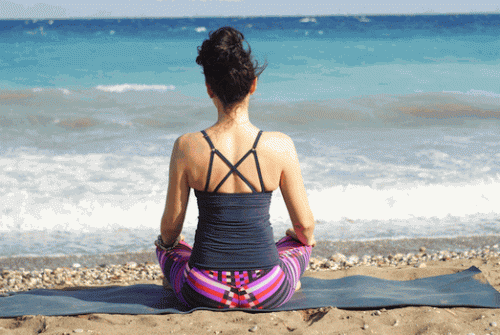
Chronic pain can stem from a variety of conditions, such as arthritis, fibromyalgia, sciatica, and migraines. Even mental health issues, such as depression and anxiety, can cause pain in the form of fatigue or muscle pain. The truth is that it would be impossible to name every single manifestation of chronic pain, but there is one thing for sure: it has a significant impact on your life. You may already be prescribed pain medication, but did you know there are natural ways to get the pain relief you seek? The following are just a few of the ways you can manage your chronic pain and get back to living.
Breathe In, Breathe Out
The pain you are experiencing takes a toll on both your mind and body, but mindfulness meditation can help with both. When practiced diligently, meditation can alter your brain pattern, thus lowering the intensity of the pain you feel by helping you to focus on the pain and address it head-on. According to Psychology Today, “This allows you to see your mind and body in action, to observe painful sensations as they arise, and to let go of struggling with them.” In essence, you are altering the way your brain processes the pain you are feeling physically and mentally, making meditation a great pain reliever. The best part is that all it takes is a quiet room or space and a computer to follow along with a guided meditation, such as those listed by Mindful. You may even be able to find local classes in your area.
When you’re putting together a good meditation space, it’s also important to actually think about the air you’re breathing. The air in our homes is often polluted, which means you will benefit from making sure it’s fresh and clean before you begin meditating. You could, for example, invest in a good air purifier to ensure that a lot of the harmful airborne particles are scrubbed from your home. Also, changing your filters on a regular basis and springing for an air filter with a high MERV rating, as well as getting a filter that’s right for your unit (a Honeywell filter will work in a Honeywell air unit, for example), can make all the difference in your home.
Lower the Stress
Chronic pain and stress feed off of one another. Think about it – if you are in pain, you are stressed, and if you are stressed, chances are, your pain is present. So, one of the keys to managing the pain is to learn how to manage stress, and it’s actually quite simple. Start by taking a look at your daily schedule and work on finding the right balance. Schedule in some “you time” and delegate what you can to others, such as having a spouse, family member, friend, or your children help with daily tasks that aggravate your pain, like household cleaning, laundry, or yard work. Make time for things that make you happy, such as reading, drawing, snuggling with the dog, or taking a long bubble bath. Make sure your home is adjusted for stress-free living by getting rid of distracting clutter to make room for a meditation space. Spend a little bit of time organizing your home and catering it to meet your needs and abilities, such as by placing all of the most-used kitchen utensils and items on the top shelf to reduce bending or simply rearranging the closet to your liking.
Believe it or not, eating a proper diet can also have a profound impact on your stress levels. For instance, the state of your gut health can have a major impact on your mood, so it’s important to pay attention to what’s happening in this particular microbiome. If the bacteria in your gut gets out of balance, not only will your mood suffer, but you might also experience everything from weight gain to uncomfortable digestive problems. Learning about probiotics and prebiotics, as well as how to introduce them into your diet, can go a long way toward improving your mood.
Supplement Your Relief Routine
Before modern medicine, healers and housewives alike had to rely on nature for pain relief. Herbs, such as lavender, rosemary, and clove, have all been shown to reduce pain when used as a topical ointment. These are not the only nature-based treatments, and your local farmers market will prove a valuable asset in your journey toward pain-free living. Cayenne pepper contains capsaicin which if used topically, affects your nervous system in a positive way blocking your body’s pain response and can help reduce sore muscles and joint pain. The Cayenne Pepper Salve Recipe is easy to make and includes only 3 ingredients: cayenne powder, olive oil, and beeswax.
Work It Out
You might think that exercising would surely exacerbate your pain, but when done correctly, it can actually ease it. Crazy, right? Well, when you exercise, your brain releases neurotransmitters called endorphins into your brain, and according to MedicineNet, “reduce our perception of pain and act similarly to drugs such as morphine and codeine.” While you probably shouldn’t go out and run a 5K, moderate exercise and stretching can increase your mobility by helping you to work through the pain, lowering inflammation, reducing stiffness, and improving your health. There are several gentle exercises you can take part in, such as water aerobics or walking, as well as various stretches. However, before you start any sort of exercise routine, be sure to speak with your doctor to be sure that it is safe for you to do so.
Chronic pain has a not-so-funny way of creeping in at the worst possible time, making daily living a nightmare. However, there are various natural pain relief methods you can incorporate to help reduce the pain and get back to living. Try some relaxation exercises, de-stress your life, and get moving – the accompanying pain relief is worth it!
About the Author:
Jackie was diagnosed with rheumatoid arthritis in her mid-20s and knows a lot about chronic pain. She shares her thoughts on how to manage pain with mindfulness, meditation and creating a healthier environment. You can learn more about her life and interests at: http://hyper-tidy.com.

